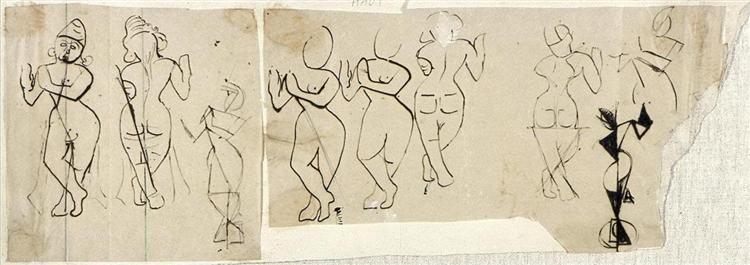Description
The work "Krishna playing a flute" by Theo Van Doesburg, painted in 1916, is presented as a fusion of spirituality and abstraction that reflects both the influence of the STIJL movement and the artist's fascination for oriental themes. Van Doesburg, known for its role as one of the most important exponents of the Dutch artistic avant -garde, use here an approach characterized by the search for harmony through formal simplification and the use of color.
In this painting, the Krishna God is the central protagonist, represented in a style that gives an account of Van Doesburg's mastery to integrate elements of the Indian iconographic tradition with a modern visual language. The figure of Krishna, although stylized, is recognized by its characteristic outfit, which includes a kind of Dhoti, an obvious touch of its cultural heritage. However, what is most intriguing is the way in which the artist has treated the figure: stripped of superfluous details, is surrounded by an abstract background that emphasizes its central role in the composition. This use of the negative space suggests a sense of depth and dimensionality, while acting as a contrast to the dense and plane approach that characterizes some of its other works.
The color palette is another of the outstanding aspects of this work. Van Doesburg uses a vibrant combination of blue and yellow, which generates an almost musical energy, as if the colors were playing a melody. This color treatment is fundamental in the work, since it not only serves to define the figure and the background, but also creates a sensory environment that resonates with the action of touching the flute. The color, together with the posture of Krishna, captures a moment of transcendence, where the divine is expressed through art.
The composition in "Krishna touching a flute" is intentionally asymmetric, which generates a deep sense of movement and dynamism in the work. The inclination of the figure to the side, together with the gesture of bringing the flute to the lips, infuses the paint with a vitality that invites the viewer to contemplate not only the image, but also the very essence of artistic creation. This is a reflection of Van Doesburg's ideology, who saw art as a means to achieve a spiritual experience.
The historical context in which this work is also offers an interesting angle of analysis. In 1916, Europe was immersed in the horrors of World War I, and art became a shelter and a means of expression of deep desires of peace and spirituality. Krishna's choice as theme seems to talk about a desire for a more harmonious world, where culture and understanding could bloom through beauty and music.
In conclusion, "Krishna playing a flute" is a work that encapsulates the essence of the avant -garde period and the style of Theo Van Doesburg. Through its master use of color, shape and composition, painting not only represents a religious issue, but also becomes an aesthetic and spiritual exploration vehicle. This work is a beautiful testimony of the ability of art to connect different cultures and ideas, revealing a path to transcendence in times of agitation. In each stroke and in each colored nuance, Van Doesburg invites us to listen to the melody that emanates from the visual experience, an echo of creation itself.
KUADROS ©, a famous paint on your wall.
Hand-made oil painting reproductions, with the quality of professional artists and the distinctive seal of KUADROS ©.
Art reproduction service with satisfaction guarantee. If you are not completely satisfied with the replica of your painting, we refund your money 100%.

